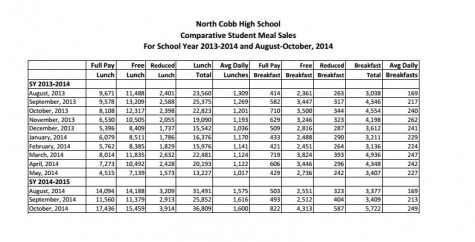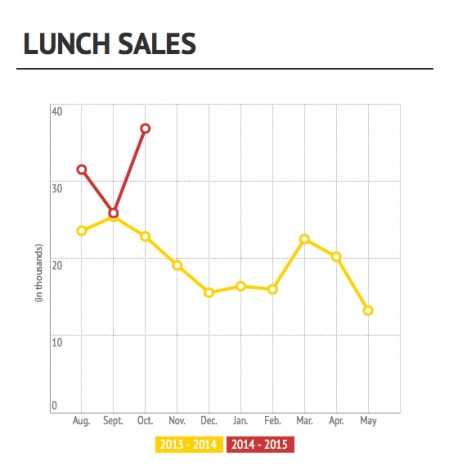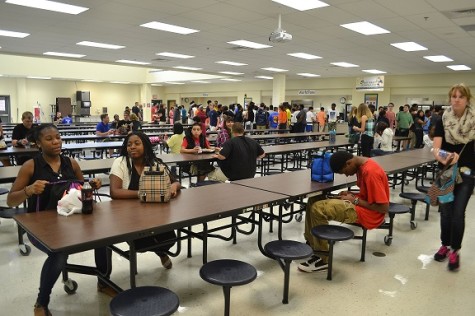Going broke going healthy
December 16, 2014
Cautiously tip-toeing within the mandates of the newly enforced Hunger-Free Kids Act, North Cobb, as well as schools across the country, forages for funding under the USDA’s intent scrutiny. Though it seems North Cobb is slowly reverting back to pre-regulation days with the return of muffins and Chick-fil-A chicken biscuits, the new USDA regulations promoting healthy eating continue to reign over public schools.
“Students are very confused when it comes to this issue. There are a lot of rumors about what’s going on. As of right now, I know it seems like things have [changed],” Stephen Revard, administrator, said, “but nothing has changed in federal legislation. Nothing. ”
With the intent to tackle staggering childhood obesity rates, the USDA banned the sale of all unhealthy foods in schools—an overwhelming legislation that shocked the system. When the act dawned in August and September, American schools and their students engulfed the USDA with complaints and objections, campaigning for the Act’s removal. Lunch became limp fries and subs with rationed toppings. Several NC students took to Twitter to protest.
“When everything first happened, Twitter went crazy. Everyone was making fun of lunch and, for some reason, attacking Michelle Obama,” freshman Rayan Ibrahim said. “Twitter connected students all over the country because we were all experiencing the change together.”
One would think wide-scale student protest would allude to plunging lunch sales. However, according to Cobb County’s school lunch records, sales have risen with the regulations, even in August, with 7,931 more sales this year. In October specifically, lunch sales rose from 22,823 in 2013 to 36,809 this year—approximately 14,000 more lunches.
However, looking at the sheer number of lunch sales can mislead to exaggerated conclusions. Contrary to this year, last year’s most popular dining option, the Grill line, was not considered “lunch.” Thus, the Grill line sales were excluded from lunch records. According to Ervin Watson, NC’s lunch department head, the Grill line sold approximately 4,600 meals in October (2013). Factoring Grill line sales into lunch records, the cafeteria sold 27,423 meals in October (2013); therefore, an approximate increase of just 9,386 lunches occurred.
Viewers of this data can fathom two theories to explain the unexpected influx:
Theory 1: An increase in student population led to the the influx.
Theory 2: Students grew to enjoy the new lunch.
According to Watson, lunch participation percentages always remained somewhat consistent, which means varying population from year to year hardly impacts sales, leaving Theory 2 standing.
“In the beginning of the year, we did see a shift student participation, especially in the Grill line. Students tend to stay in their comfort zones,” Watson said. “They would rather get a sub than to try something new. But as the semester progresses students are beginning to warm up to more of the food options we offer. Currently, the Grill line still makes the most sales. It’s actually making more sales than it did last year.”
As confusion brewed in the cafeteria, finances shriveled in the school. The battle over the Act grew more ardent, with the USDA tenacious about ending American childhood obesity and schools nostalgic of high volumes of fundraising revenue. NC’s most prominent food fundraisers, Mr. Dennard’s school store and Tribal Connections’ Chick-fil-A chicken biscuits endured a crippling blow. Mr. Dennard’s snack-based school store provided business and marketing classes a place to practice learned skills, and the much loved Chik-fil-A chicken biscuits fundraiser funded a majority of NC’s activities, generating approximately $29, 000 last school year, $800 per week. Homecoming, Prom, the annual Senior Carnival, The Tribe App, and all other activities and paraphernalia a part of the NC experience were all funded by chicken biscuits.
Left without fundraising mediums, schools watched money dwindle from their fingertips. Everyday was a lost opportunity and the schools were fed up.
“I think childhood obesity is definitely something that needs to be addressed,” Revard said. “If I were to attack childhood obesity, I would make P.E. mandated for all four years of high school. Eating is a small portion of maintaining a healthy life.”
To simmer the uprising of schools across the state, the Georgia government initiated a series of meetings throughout September to sort out specifics the USDA left states to manage. Several additions were made throughout this semester. Though the Act outlaws food fundraisers that do not comply with the regulations, it renders “infrequent fundraisers” exempt. Hearing the outcry of struggling schools, Georgia defined infrequent fundraisers as lasting 90 school days or less and introduced a waiver system. Thus, the return—or visit—of muffins and chicken biscuits.
DECA and Tribal Connections commenced their waivers on October 27, which sets the fundraisers’ last sale date, along with the perceived end of the world, on April 22, 2015. DECA and Tribal Connections are currently brainstorming new fundraising ideas, though the regulations make it difficult.
“The store wasn’t really used to make money; it was really for my business classes. We made 1-2 % profit on the muffins—everyone expects everything to be a dollar. When we’re not selling muffins, it hurts,” Dennard said. “We’re looking at a few items that might fall within the regulations.”
The general consensus of the regulations here at NC stands at “I understand the regulations’ purpose, but…” Students, teachers, administrators, and staff see room for improvement.
“They shouldn’t have done it this way,” bookkeeper Cindy Turner said. “There are so many other routes they could have taken to reduce the childhood obesity rate but they decided to do it this way. What they don’t realize is food fundraisers generate the bulk of the school’s revenue. It’s sad.”




